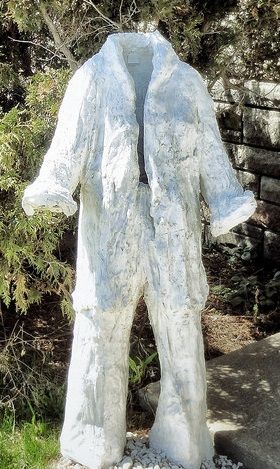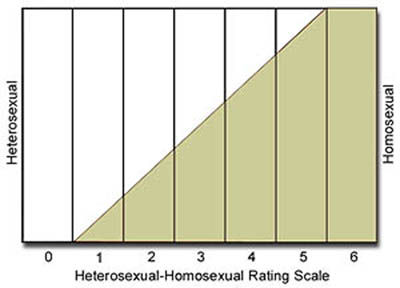
Charles is a 20 year old male. Last week he came out to his family. His 24 year old brother, Marcus, by his overt behavior is assumed by all to be straight, although he has never ‘come out’ as heterosexual.
In neither situation, though, does anyone disbelieve either brother’s presenting sexual orientation.
Jill is a 27 year old woman who has come out as lesbian and who is in a committed relationship with her girlfriend, Susan. Her cousin Shawna is married to her college sweetheart, Joey, and, again, has never officially had to’ come out,’ but appears by all accounts to be heterosexual.
Again, no one questions either woman’s sexual orientation.
But suddenly Marcus brings home a man and tells everyone the two are dating. When Charles makes a comment saying he's surprised that his brother is gay, Marcus says, “no, actually, I’m bisexual.”
And what if Shawna had dated both men and women in college before meeting Joey? Is she now bisexual?
What I’m trying to get across here is that bisexual individuals encounter a unique social stigma, one no other sexual orientation faces. Their orientation is often not believed by either heterosexuals or gay men or lesbian women.
Female Bisexuality: It’s Just a Phase
It is well documented that women self-report, and people observe, greater sexual fluidity in women (Esterline & Galupo, 2013). This means that women will engage in more same sex behavior than men and yet still be thought to be heterosexual. In a study my colleague, Dr. Shani Habibi, and I conducted we found that a hypothetical woman wasn’t as equally likely to be labeled bisexual as a similar woman was to be labeled heterosexual until she had engaged in repeated highly intimate behavior (e.g. oral contact with a woman’s genitals more than once) (Swan & Habibi, 2015). (Interestingly, kissing a woman, even if repeated, didn’t result in the woman being labeled bisexual.) In fact, research shows that, not only is it fairly common for college-aged women to engage in same-sex activity, especially kissing, but that this behavior is often encouraged by straight males (Yost & McCarthy, 2012).
This “performative” bisexuality leads to the social belief that female bisexuality is ‘just a phase,’ one that a woman will grow out of when she matures and meets the right man.
Male Bisexuality: Just Chicken?
On the contrary, males are given very little sexual latitude in our culture. They are afforded no experimental phase or a period when their peers encourage male-male sexual behavior. In fact, many people ascribe to the belief that if a man has any same sex experience, he is automatically gay. The popular social belief is that bisexual men are really gay but are too afraid to come all the way out; they’re social chickens denigrated by straight and gay alike (Flanders & Hatfield, 2012).
Bisexuality and Timing
One final problem unique to bisexual individuals is society’s tendency to define people’s sexual orientations based on their current relationship status. You’re a man in a relationship with a woman? You’re straight. In a relationship with a man? You’re gay. Nice and neat and simple, right? No need to even come out. Just let your relationship do the talking. Not for bisexual individuals. Many bisexual people struggle with their public orientation because it doesn’t tell the whole story and many bisexuals face strong social judgment if they try to assert their bisexual orientation in the face of their current monosexual relationship.
Bi-stigma
In addition to having their sexual orientation not believed by people, bisexuals face a unique double stigma from both heterosexual and gay and lesbian communities for being “fake” heterosexuals or homosexuals. In fact, many people of both groups feel that bisexuals can’t be trusted and bisexuals are led to feel like imposters in either setting. For these reasons, many bisexuals do not come out, and, yet, they comprise 40% of the LGBT umbrella (PEW, 2013).
Bi-erasure in sex education
One final place where bisexuals are, again, denied a place in the discourse is sex education. Almost all sex education programs in the United States neglect specific inclusion of bisexuality or, if mentioned at all, lump them in the umbrella of LGBT (Elia, 2010). This absence of discussion further contributes to bisexuality being an invisible orientation rendering it not even relevant enough to discuss in a course on sexuality.
Prevalence
What makes this invisibility and erasure puzzling is that, according to Alfred Kinsey, the majority of people, about 80%, would be classified as bisexual to at least an incidental degree (1947). Kinsey was the first person to try to measure sexual orientation on a continuous scale. As you can see in the figure below, of the seven points on the scale, five of them result in a classification other than purely hetero- or homo- sexual. However, finding reliable data on the prevalence of bisexuality is compounded by the difficulty with defining it. For example, in a CDC study, 65% of women who had had a sexual relationship with a woman still considered themselves heterosexual (2002). While there is a power movement in the United States toward allowing people to self-identify whatever orientation they want, as a researcher, this presents a significant roadblock to scientific data collection. But I’ll save that discussion for another day.

Who Cares?
The bottom line to all of this is that there are some important real world implications of bi-erasure. Bisexual individuals are significantly less likely to come out than other sexual minorities. For example, while over 70% of gay men and lesbians report being out to their significant relationships, only 33% of bisexual women and just 12% of bisexual men are. Being ostracized by both heterosexual and homosexual communities and invisible in sex education programs, a majority of bisexuals feel a sense of isolation. Further, due to so few bisexuals being out, and with very few public role models, bisexuals have no sense of community or belonging. As a result, bisexual individuals experience some very negative mental and physical health effects. Bisexuals are more likely to report mood or anxiety disorders and lifetime suicidality than heterosexuals (Brennan, Ross, Dobinson, Velhuizen, & Steele, 2010; Kerr, Danturri, & Peters, 2013) and homosexuals (Steele, Ross, Dobinson, Veldhuizen, & Tinmouth, 2009). Bisexual women also report higher rates of sexual abuse and rape (CDC, 2013).
One of the major barriers to embracing “yet another” sexual orientation is that humans are cognitive misers. This means that we want to expend as little cognitive energy as possible because, frankly, thinking is hard work. Therefore, we develop shortcuts to bypass having to think through issues. One of these shortcuts is to categorize people. It is easy to just assume everyone is heterosexual. It’s a little harder, but still doable, with practice, to add homosexual. But it takes more work to hold out for bisexual categorization because you can’t simply rely on an individual’s current (or past) relationship. But doing so is required of us. Invisible, disbelieved, and erased should not be the adjectives used to describe anyone.




